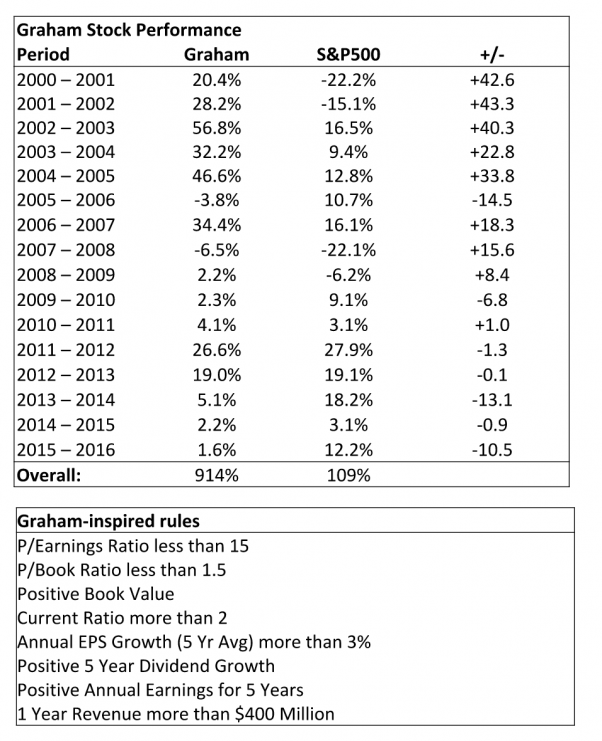Graham Stocks For 2017
 It's easy to get caught up in the casino-like atmosphere of the market. But betting on the hot stocks of the day often leads to disappointment because they rarely live up to expectations. It's one reason why Benjamin Graham, the father of value investing, advocated taking a measured and longer-term approach.
It's easy to get caught up in the casino-like atmosphere of the market. But betting on the hot stocks of the day often leads to disappointment because they rarely live up to expectations. It's one reason why Benjamin Graham, the father of value investing, advocated taking a measured and longer-term approach.
I'm pleased to say that my take on Mr. Graham's method for defensive investors trounced the market since it was launched in the Canadian MoneySaver just after the turn of the century. If you had purchased an equal dollar amount of each Graham stock in the first year and replaced them with the new crop of stocks each year thereafter, you would have turned $1,000 into $10,140. In comparison, $1,000 invested in an S&P 500 Exchange Traded Fund (NYSE:SPY) would have grown to just $2,090. Translated into percentage terms, the Graham stocks gained 914% (16% annualized) over the full period while the S&P 500 ETF moved up 109% (5% annualized).
I hasten to add that the Graham stocks didn't outperform each and every year. After all, the market is far too wild and woolly for that. Last year was a bad one because the Graham stocks only gained 2% while the market climbed 12%. But this sort of thing has to be expected occasionally.

You can see the full performance record in the accompanying table. The return figures are provided in U.S. dollar terms, reflect periods between data collection, and include dividends that are reinvested each year when the new stocks are selected. They do not include inflation, taxes, fees, or trading costs like commissions.
Benjamin Graham's method for defensive investors is described in his book The Intelligent Investor, which should be on every investor's bookshelf. While the original is a little dated, the 2003 edition (ISBN 0060555661) has more modern commentary from veteran columnist Jason Zweig. Serious Graham buffs should also invest in a copy of the sixth edition of Security Analysis (ISBN 0071592539), which includes commentary from some of today’s most famous value investors. However, the second tome can be daunting for both new and old investors alike.
Mr. Graham’s original rules for defensive investors set a very high bar for stocks to pass. Indeed, no North American stock was able to jump over that bar for most of the last two decades. That's why my version employs a slightly more lenient approach. The main criteria I use are summarized in the accompanying table.
For instance, I differ with Mr. Graham when it comes to dividends. He originally demanded a twenty-year record of uninterrupted dividend payments whereas I require only some dividend growth over the last five years.
Even with my slightly more relaxed requirements, very few U.S. stocks usually pass the test. At market lows, such as those seen in the spring of 2009, there might be dozens of defensive stocks. But in more normal times less than ten companies make the grade. This time around two stocks passed the test. They're highlighted in the accompanying table.

It is important to be aware that a well-diversified portfolio should hold at least ten stocks and usually many more. Holding a very concentrated portfolio is itself a source of risk. After all, a few individual disasters can really hurt in such cases. That's why it's best to add the defensive stocks to an already reasonably diversified portfolio.
As always, before buying each stock it is important to examine it in great detail. Dig through the numbers and consider the less tangible aspects of each company. Get up to speed by reading news stories about the company along with its press releases and regulatory filings.
While my take on Graham’s defensive method has avoided serious trouble so far, it can’t be expected to outperform all of the time. After all, despite its excellent long-term track record, it has trailed the market in seven of the last sixteen years and lost money twice.
So dive in only after you've taken the time needed to become comfortable with the method and value investing more generally. Even when you do, I suggest starting off in a small way with a modest amount of capital because sticking with value stocks through thick and thin can be harder than most investors expect. But those who stand the test of time will likely be rewarded handsomely.
Norman Rothery, PhD, CFA, Founder of StingyInvestor.com, Toronto, ON (416) 243-9580, rothery@stingyinvestor.com, www.stingyinvestor.com

